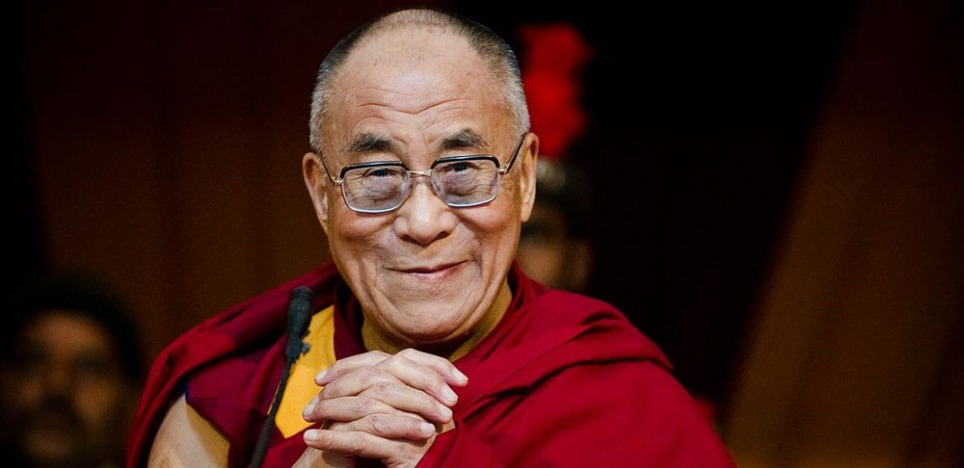Tenzin Gyatso, His Holiness the 14th Dalai Lama of Tibet, has touched far more than just the hearts and minds of the Tibetan people, for whom he is a beloved spiritual and temporal leader. Now in his 80s, his wisdom, compassion, peacemaking, interfaith endeavors, scientific curiosity, and delightful sense of humor make him a shining light for countless people from all walks of life and all religious traditions. He accepts invitations from around the world to give public talks for non-Buddhist audiences of thousands, to offer his students teachings on classic Buddhist texts and commentaries, and to engage in dialogue with religious and political leaders.
Born in 1935 to a farming and horse-trading family in a small village in northeastern Tibet, His Holiness was given the name Lhamo Thondup. He spent his first two years in simple rural family life. Then everything changed. Guided by premonitions, signs, and clues in accordance with Buddhist tradition, a search party sought him out as a possible reincarnation of the 13th Dalai Lama. Its leader, Sera Lama, pretended to be a servant and sat alone in the kitchen with the previous Dalai Lama's prayer beads. When the young boy approached him and asked for the beads, the lama replied, "If you know who I am, you can have them." The boy replied, "Sera Lama, Sera Lama," speaking in the accent of Tibet's capital city, Lhasa — an accent that his mother couldn't understand! Several similar tests convinced members of the search party that they had found the next successor to the Lion Throne, a position earned through rebirth rather than inheritance.
He was brought with his family to Lhasa for training and given the religious name Tenzin Gyatso. At age 15, with Communist Chinese troops infiltrating Tibet, he became Head of State and Government, three years before the traditional age for ascending to the throne as Dalai Lama. Forced into exile in 1959 when his efforts to bring about a peaceful solution to the Sino-Tibetan problem were thwarted, he received political asylum in India. From there, he oversaw education, rehabilitation, and efforts to preserve culture for Tibetan refugees. As his influence continued to grow, he worked tirelessly on behalf of human rights and world peace. He received many international awards, including the 1989 Nobel Peace Prize. You can learn more about his life and teachings in our Living Spiritual Teachers Project.
 Quotes
Quotes
We honor His Holiness today by making our own best efforts to bring about the "spiritual and ethical revolution" — one of compassion, generosity, patience, forgiveness, and mutual understanding — around which he has based his life. Take one of these quotes to guide your efforts this week:
"Whether one is rich or poor, educated or illiterate, religious or nonbelieving, man or woman, black, white, or brown, we are all the same. Physically, emotionally, and mentally, we are all equal. We all share basic needs for food, shelter, safety, and love. We all aspire to happiness and we all shun suffering. Each of us has hopes, worries, fears, and dreams. Each of us wants the best for our family and loved ones. We all experience pain when we suffer loss and joy when we achieve what we seek. On this fundamental level, religion, ethnicity, culture, and language make no difference."
— in Toward a True Kinship of Faiths
"Some people think that cultivating compassion is good for others but not necessarily for themselves, but this is wrong. You are the one who benefits most directly since compassion immediately instills in you a sense of calm (nowadays medical researchers have shown in scientific studies that a calm mind is essential for good health), inner strength, and a deep confidence and satisfaction. . . ."
― in How to See Yourself As You Really Are
"Regarding my actual daily practice, I spend, at the very least, five and a half hours per day in prayer, meditation, and study. On top of this, I also pray whenever I can during odd moments of the day; for example, over meals and while traveling. In this last case, I have three main reasons for doing so: first, it contributes toward fulfillment of my daily duty; second, it helps to pass the time productively; third, it assuages fear! I see no distinction between religious practice and daily life."
— in The Path to Tranquility
 Spiritual Practices
Spiritual Practices
Br. David Steindl-Rast, a renowned Catholic author and speaker who is friends with His Holiness the Dalai Lama, asks, "If you had to select a single word for what makes the Dalai Lama so special, which would it be? For me, it is the word 'all-embracing.' His compassion embraces not just Tibetans or Buddhists, but all people everywhere; and it embraces all of every person — mind, soul, and body. I experienced both. Once, when I was privileged to sit next to His Holiness while someone else was lecturing, he noticed that both of us were fingering our prayer beads. Quietly, he reached over, took the string of beads I was using, and let me use his. With this one gesture, a Buddhist embraced all Christians. On another occasion, he noticed that my hands were cold, simply took them between his own hands, and rubbed them, as a mother might do with a child. With this one gesture, another human being embraced all of me."
What is one simple thing that you can do today that demonstrates your complete embrace of another person's way of being?
